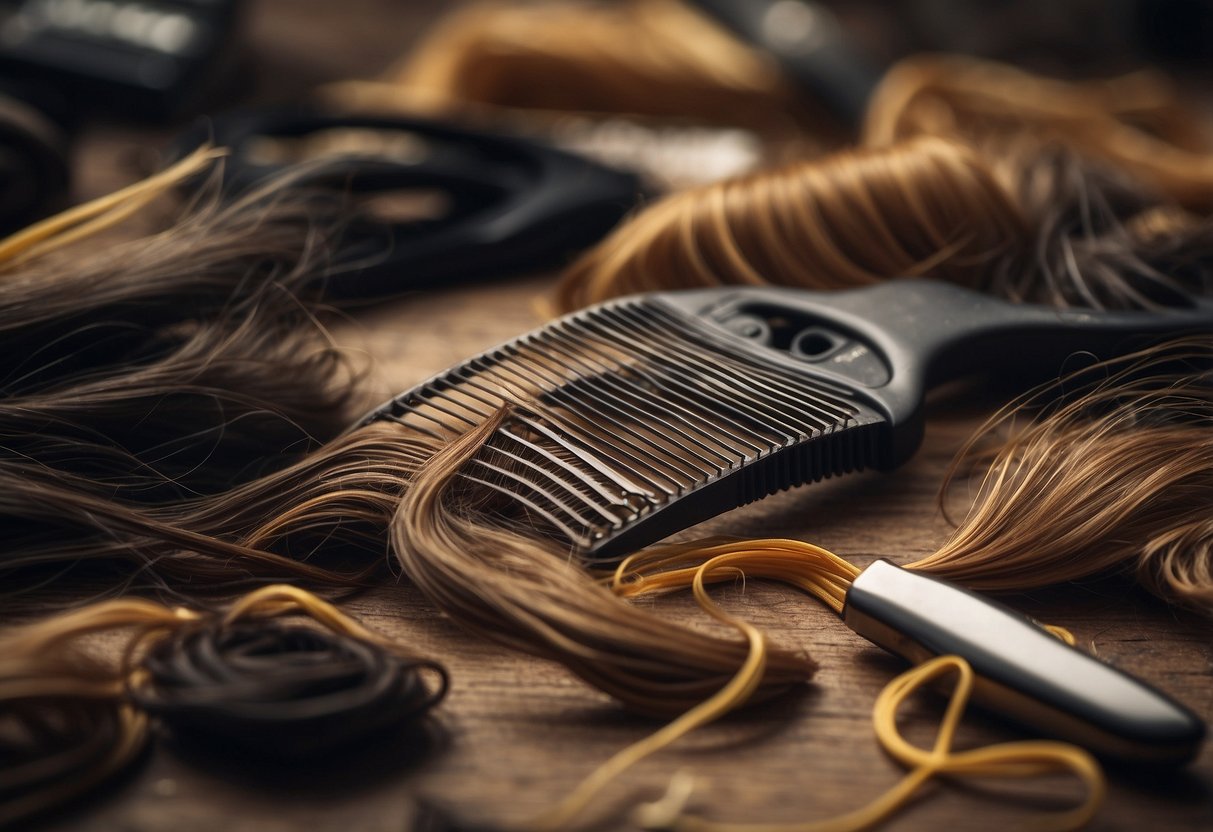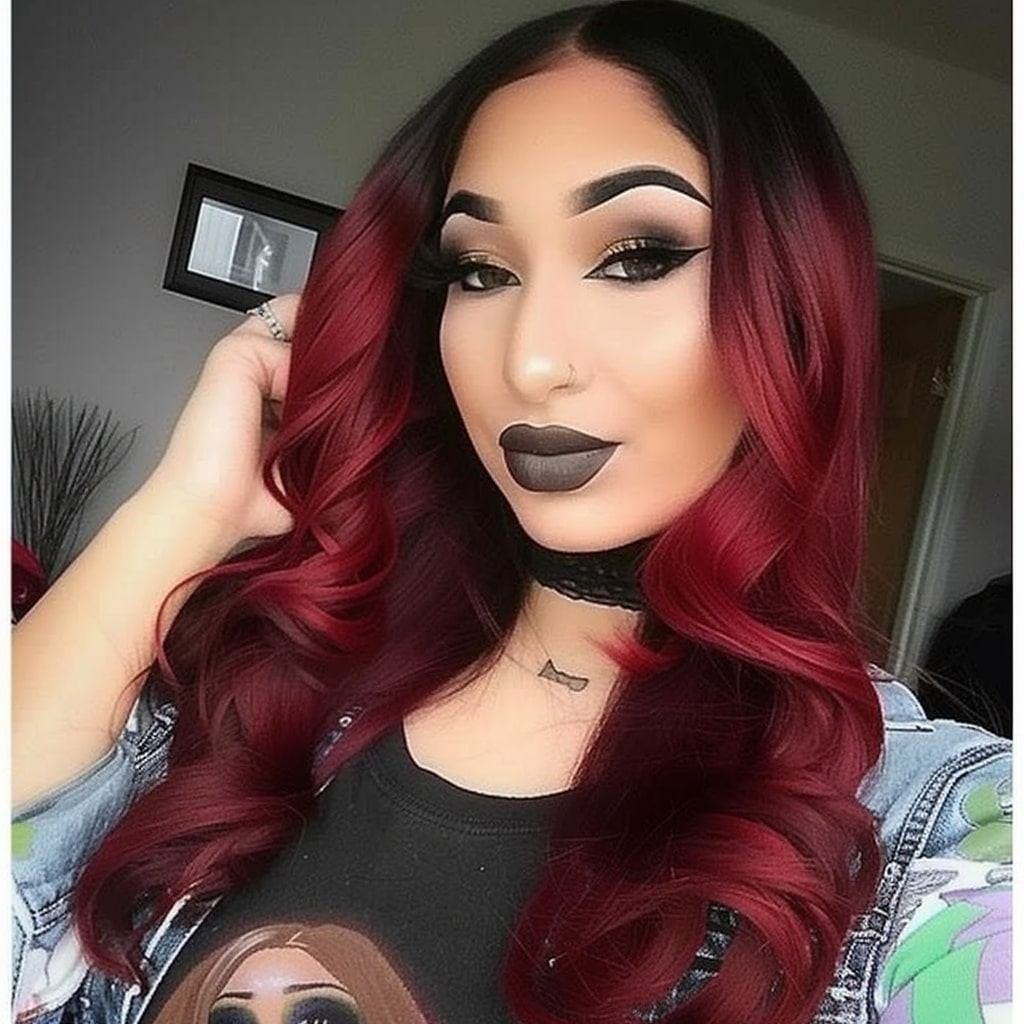Why Aren't My Tape-In Extensions Sticking? Common Causes and Solutions

Tape-in hair extensions are a popular choice for adding length and volume to one's natural hair. These extensions offer a seamless look, but their success hinges on proper application and maintenance. Many users face issues with the extensions not sticking well, often due to improper techniques or incompatible products.
Ensuring the hair is clean and free of oils and moisture is critical for the tape to adhere properly. Additionally, using high-quality tape and pressing it firmly for at least ten seconds can strengthen the bond. Correct spacing is also essential, as placing the tape too close to the scalp can create tension and discomfort.
Key Takeaways
- Clean, oil-free hair is necessary for effective adhesion.
- High-quality tape and firm application secure the bond.
- Proper spacing reduces tension and improves hold.
Learning About Tape-In Extensions
Parts of Tape-In Extensions
Tape-in extensions include small sections of hair connected to thin, sticky strips, known as tapes. The adhesive is made to be strong to keep the extensions in place while being gentle enough to avoid harming your natural hair. Using high-quality tapes is important to ensure a secure and long-lasting hold. Regular care and the correct application are necessary to maintain the extensions' natural look. It's essential to avoid water or oil on the adhesive, as these can weaken the bond.
Benefits of Tape-In Hair Extensions
Tape-in hair extensions have several positives. They naturally mix with your own hair, giving a seamless look. They are quicker to apply than other types of extensions, often taking less than an hour. Compared to other methods, they are less damaging because they don't need harsh chemicals or tools. These extensions are also light, making them comfortable for everyday wear. With good care, they can last for several weeks, offering a flexible and easy option for enhancing hair.
Using these extensions provides a natural appearance, quick and easy application, minimal damage, and comfort.
Correct Application Methods
Getting the Scalp and Hair Ready
Cleanliness is crucial. Wash the hair with a shampoo that does not contain sulfates to remove any buildup of oil or residue. Completely dry the hair before starting. Do not apply conditioners or oils near the roots, as they might interfere with the adhesive. Brush the hair well to get rid of any tangles.
Make sure the scalp is healthy. Issues like dryness, oiliness, or dandruff can impact how well the tape sticks. Regularly exfoliating and moisturizing the scalp can enhance the application.
Sectioning and Placement Plan
Accurate sectioning lets the tape tabs mix naturally with the wearer's hair. Create small, clean sections with a rat tail comb. Make sure to leave about an inch from the hairline to prevent visible tape when the hair is styled back.
When sectioning, do not make the sections too thick or too thin. The hair should be thin enough for the tape to stick well but thick enough to support the extension's weight. Striking this balance is important for both the appearance and the health of natural hair.
Attaching the Tape Strips
Position the first tape strip under a section of hair, close to the scalp but not directly on it. Press the hair onto the tape, ensuring the strands are spread evenly across the adhesive surface. Next, apply the second tape strip on top, sandwiching the natural hair between the two.
Use a pressing tool or fingers to press the tape strips together snugly. This ensures a solid bond. Avoid touching the adhesive with fingers, as oils from the skin can reduce effectiveness.
Regularly check for any loose strands that could slip out of the tape strips. This step helps avoid later slippage and achieves a smooth, natural look. Proper attachment is key to long-lasting extensions.
Potential Causes for Non-Adherence
Oils or Hair Products
Oils, whether from your scalp or hair care products, can hinder the effectiveness of tape-in extensions. Oils create a slick surface, making it hard for the adhesive to stick. Even small amounts of oil can lead to the tape losing its grip.
Products like conditioners, serums, and sprays can also leave residues that affect the tape's hold. To combat this, ensure your hair is thoroughly washed before applying extensions. Using a clarifying shampoo can help remove product build-up.
Additionally, avoid oil-based products near the roots where the tape is applied. This helps maintain a strong bond between the tape and your hair.
Wrong Tension on Extensions
The tension used when attaching tape-in extensions is important for their adherence. Too much tension can cause the extensions to loosen or unstick over time.
Extensions should be applied with just the right amount of tightness. They need to be snug but not overly tight. Excess tension can not only cause adherence problems but also lead to discomfort and possible hair damage.
When applying the extensions, press and hold the tape firmly for at least 10 seconds. This helps the adhesive bond better, reducing the risk of the extensions slipping or coming loose. Proper application methods can address many common issues related to tape-in extensions.
Maintenance and Aftercare
Routine for Cleaning and Shampooing
Maintain the cleanliness of hair extensions by washing them at least once a week using a shampoo that is free of sulphates. Sulphates can damage the adhesive, resulting in less sticky tapes. While washing, focus on cleansing the scalp and roots, but be careful to not scrub directly on the tape area.
Ensure a thorough rinse to eliminate every bit of shampoo and other product buildup. Any leftover residue can make the tape slip. After cleansing, apply a lightweight conditioner only to the mid-lengths and ends, steering clear of the tape sections.
Controlling Natural Oil Production
Natural oils from the scalp can weaken the adhesive bond of the tapes. To control oil production and maintain the tapes, steer clear of oily hair products near the tape areas. Dry shampoo can help manage oiliness between regular washes.
Gently brush the hair from roots to ends using a brush that's suited for hair extensions. This helps to spread oils away from the tape region. If the scalp is naturally oily, more frequent washing might be necessary to keep oils in check.
Advice for Prolonging Tape-In Stickiness
Avoid applying heat directly to the tape areas. High temperatures can melt the adhesive, causing it to lose its sticking properties. Use a heat protectant spray and set styling tools to a low temperature when styling.
For drying the hair, use a low heat setting or opt for air-drying whenever possible. Sleeping on a satin pillowcase can reduce friction and help prevent tapes from pulling.
Should any tape start to lift, re-tape the extension promptly to prevent further slippage. Keep extra tape strips handy for quick adjustments.
Solving Frequent Issues
Fixing Loose Extensions
When tape-in extensions start to loosen, the first step is to find the problematic sections. Carefully separate and focus on the areas that need attention. It is crucial to clean both the hair and the roots of the extensions thoroughly to remove any oil buildup. Oils can make it difficult for the adhesive to stick properly.
Invest in high-quality tape meant specifically for hair extensions. Cut it to the appropriate size and apply it to the extension. Hold it in place firmly for at least 10 seconds to ensure a strong bond. Using a positioning spray can further secure the attachment.
For extra adhesion, consider drying the adhesive with a blow dryer set on a low heat. This step helps activate the glue, making it more effective. Always make sure both the hair and the adhesive are clean and dry to achieve the best results.
Getting Help from Customer Service
If DIY solutions don't resolve the issue, it may be time to reach out to customer service. Provide them with thorough details about the problem and the actions you've already attempted to fix it.
Customer service can offer useful advice on proper application methods or suggest better products to use. They might also replace the extensions or adhesive if they are found to be defective. It's a good idea to keep any receipts or order details handy to facilitate quicker service.
If issues persist, professional help from a stylist can be invaluable. A stylist can ensure that the extensions are applied correctly, reducing the likelihood of future problems and giving you peace of mind.
Frequently Asked Questions
Tips to Make Tape-In Hair Extensions Stick Better
Using quality tape is essential for keeping tape-in extensions in place. Ensure the hair is completely clean before applying extensions. Preparing and drying the hair thoroughly creates a surface that helps the tape adhere properly. Pressing and holding the tape firmly on the scalp for at least 10 seconds also contributes to better adhesion.
Managing Tape-In Extensions That Slip Out Shortly After Application
If extensions slip out soon after they are applied, the hair might not be clean or may have oils on it. Using a clarifying shampoo can help. Adding a positioning spray before pressing the tape can improve the bond. Make sure to press the tape tightly during the application to secure it better.
Impact of Regular Washing on Tape-In Extension Adhesive
Frequent washing and using heavy or oily conditioners can weaken the adhesive on tape-in extensions. Opt for gentle, sulfate-free shampoos and avoid applying conditioner near the tape area. Washing hair less often helps maintain the adhesive's strength.
Solutions for Removing Sticky Residue from Tape-In Hair Extensions
Specialized tape removers designed for extensions are effective for eliminating sticky residue. Apply the remover according to instructions, then comb through the hair gently. Avoid pulling to prevent hair damage. Rinse the hair thoroughly and repeat if needed to ensure all residue is removed.
Best Methods for Applying Tape-In Extensions to Thin Hair Without Slippage
In thin hair, avoid placing tape-in extensions too close to the hairline, leaving at least an inch of space to avoid visibility. Use smaller hair sections within the extensions to evenly distribute the weight and lessen the stress on the hair, helping prevent the extensions from slipping.
How to Securely Reattach Tape-In Hair Extensions at Home
For reattaching tape-in extensions, start by removing the old tape and cleaning the extension. Apply new, high-quality tape and press it firmly onto the extension. Make sure the natural hair is clean and dry before reapplying the extensions. Press the tape firmly to the scalp during reapplication for a strong bond.
Frequently Asked Questions
How can I prevent my tape-in extensions from slipping after washing?
To stop tape-in extensions from slipping, avoid using products with oil. Oil can weaken the adhesive. When washing, use a mild, sulfate-free shampoo. Gently pat your hair dry with a towel and avoid scrubbing.
What are the best practices for ensuring tape hair extensions adhere properly?
First, ensure your hair is clean and free from oils. High-quality tape designed for extensions should be used. Press and hold the tape firmly for about 10 seconds to activate the adhesive. Slightly heating the tape with a flat iron can also help.
How can I fix tape-in extensions that are falling out at home?
If extensions are falling out, ensure your hair is dry and clean. Reapply fresh tape to the wefts and press firmly. You can carefully use a flat iron on a low setting to reinforce the bond.
Why do my tape-in extensions feel sticky and how can I address this?
Sticky tape-in extensions might be due to leftover adhesive or product build-up. Gently clean the sticky areas with an adhesive remover or a mix of water and a little bit of shampoo. Rinse thoroughly and allow them to dry completely before reapplying.
What could be causing my tape-in extensions to fall out after only a week?
Several factors might cause premature falling out, including improper application, oily products, or not pressing the tape firmly. Ensure you follow the correct steps when applying and avoid using heavy conditioners near the tape.
Is there a way to rebond tape hair extensions that are not sticking?
Yes, you can rebond them by cleaning the wefts thoroughly, removing any old adhesive, and applying new tape. Press and hold firmly, then optionally apply slight heat with a flat iron for a stronger hold.

 My Store Credit
My Store Credit
 Buy Again
Buy Again






